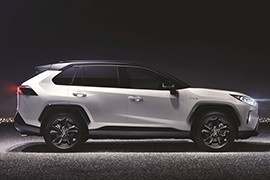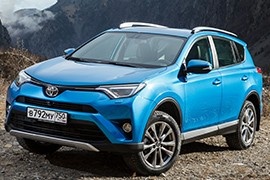
TOYOTA RAV4 5 Doors
Generations Timeline, Specs and Pictures

Toyota dropped the anonymity design from the Rav4 when it introduced the fifth generation of its compact SUV model at the 2018 New York Auto Show.
When the SUV sales started to rise, Toyota already had the first generation of the Rav4 on the market. Its well-known experience in the 4x4 segment and the trustworthy models transformed it into a best-seller worldwide. The car’s only drawback was its modest design, not bold enough for what the car was capable of. But that changed with the fifth generation.
The five-door Rav-4 featured an angular design at the front, with swept-back headlights and multi-stage A-shapes on the bumper and grille. Maybe the car designer responsible for that was a Darth Vader fan. On the sides, the sculptured door panels and enlarged wheel fenders reminded the customers that the carmaker was a capable 4x4 maker. In the back, the Rav-4 dropped the flat rear end and offered a raked-forward C-pillar and windscreen.
Inside, the carmaker continued the wedged shapes and, apart from the round steering wheel and climate control dials, all the dashboard lines were angular. A floating touch-screen display adorned the top of the center stack and featured the Toyota Entune 3.0 system. The front bucket seats separated by a tall center console were designed for comfortable rides, while in the back, the carmaker installed 60/40 split-folding seats with a lower center tunnel.
Under the hood, the carmaker introduced one gasoline engine and three hybrid versions paired either with an eight-speed automatic or a CVT. Front or all-wheel-drive systems were available.

With crossovers being en vogue, the 2015 Toyota RAV4 was one of the most versatile car in its class.
The RAV4 had an easy-to-park size, a good fuel consumption (although not leading in its class) and a good size trunk with lots of versatility included with the cargo bay’s low load floor. The upper trims had an optional adjustable-height power liftgate.
The RAV4 was offered in three trim levels: LE, XLE and Limited.
The base model was well-equipped, with standard 17-inch steel wheels, automatic headlights, power-folding mirrors, air-conditioning, cruise control, a rear-view camera, Bluetooth phone and media streaming, as well as a 6.1-inch touchscreen with an AUX jack and an iPod audio interface.
The upper trim added alloy wheels, heated side mirrors, foglights, a sunroof, roof rails and many more.
The top of the range had a premium 11-speaker audio system from JBL and new technology such as a blind-spot warning system with rear cross-traffic alerts, a lane departure warning system and automatic high-beam.
Only one engine option was available with the new RAV4, and that was a 2.5-liter 4-cylinder engine that would be adequate for most situations. The 176 hp engine was mated with a 6-speed automatic transmission.
The interior had a modern look, with good quality materials.

Toyota introduced a second facelift for the Rav4’s third generation in 2010, a generation that was only five years old.
The carmaker tried to make a signature front fascia for its entire range, and most of its cars started to look like they borrowed the headlights from one to another. On the plus side, it was easier to spot a Toyota without wondering the brand. Only the model.
The slimmer yet angled headlights made room for a thicker front bumper, and the car designers rushed to add larger fog lights in the apron. Its waved grille, with three slats in a reversed trapezoidal grille, wore the company chromed badge in the middle. As part of the pedestrian protection equipment, Toyota shaped the apron and gave it a small spoiler, which was meant to catch the pedestrian legs and not ramming over. The carmaker replaced the quarter panels to make room for the bigger, redesigned taillights in the back.
Inside, the carmaker installed a new steering wheel with a sportier look. On the center stack, a revised navigation system, fitted as an option, was optimized.
But the most important updates were on the technical side. Toyota introduced an evolved IADS (Integrated Active Drive System) that could vary the torque distribution from 100:0 to 55:45, depending on the surface condition. When the system detected a dry paved road, the system sent all the power to the front wheels, allowing the car a better fuel-efficiency.

The fourth generation of the Toyota Rav4 compact SUV was unveiled in November 2012 at the Los Angeles Auto Show as a 2013 model.
Like its predecessor, the third generation, it was available only in a 5-door version.
Toyota made a mix between its status as a 4x4 car-manufacturer and its sedans and the result was the Rav4. The first generation was launched in 1994 and it was based on the Corolla platform, The third and fourth generations were sitting on the Toyota’s New MC Platform.
The 2012 generation featured a more dynamic look, with a raked front fascia and windshield. It had the same design language as the compact sedan and hatchback Corolla. The curved roof was sloped toward the rear of the car. The tailgate spare-wheel was no longer mounted on the tailgate, as on its rear predecessors. The overall length of the car was bigger than its predecessor.
Inside, there was room enough for five adults and lots of luggage. In the base trim level, the Rav4 came equipped with Bluetooth connectivity, steering-wheel buttons, and a climate control unit. For the hybrid version, the list was even bigger with an up-scale infotainment unit.
Under the hood, Toyota installed diesel, gasoline, and hybrid versions, to suit the needs of everyone. Automatic transmission and all-wheel-drive were available, but a 2WD version was on the list as well.

Toyota rolled out a brand new facelift in 2009, this time concerning only certain markets, with changes related to appearance and engine performance.
While the exterior modifications are easy noticeable (redesigned headlamps and taillights, reshaped front grille and bumper), the performance area got enhanced with an upgraded 4-cylinder engine focused on fuel efficiency but without neglecting overall output. New features were also debuted, including a back-up camera for easier parking, satellite navigations, push start button and keyless entry. The new model is scheduled to arrive in production in the first months of 2009.

The 2006 model of Toyota RAV4 marks the beginning of the third generation of this small SUV which is now available in a single 5-door body version.
The new RAV4 is pretty different from the previous models, being developed on a new platform and including features that were not available on the earlier cars. However, it still uses the 2.4 liter four-cylinder engine but, in comparison with the 2000 edition, it develops 166 horsepower. Although it is only manufactured in Japan at two factories, Toyota will open the gates of a new plant in Canada which will produce cars addressed exclusively to the North American market.

Toyota introduced the Rav4’s second generation in 2000 and, by 2003, it considered that it was time for a refreshed lineup for both three and five-door versions.
By 2003 the SUVs were in high demand pushing aside most of the station wagons from the market. Their 4x4 abilities that could tackle snowy conditions and grass-covered areas brought them into more and more customers’ driveways. As a world leader in the automotive industry, Toyota pushed its second generation of the compact Rav4 further on the market by improving it in 2003.
While the three-door version was fit mostly for those who didn’t need rear seats or long wheelbases, the five-door version was the all-around vehicle fit for everyone to go anywhere. It didn’t sport a very bold design but tried to get more attention with its swept-back angular headlights with orange turn-signals and the rectangular grille with two black slats. In the back, the facelifted version featured smaller reversing lights mounted in the middle of the taillights.
Inside, Toyota installed a revised interior with an infotainment unit on top of the center stack. In the instrument cluster, the tachometer took center stage while a larger speedometer claimed the left side. Its longer wheelbase allowed better seating for three passengers in the back but still cramped due to the transmission tunnel.
Under the hood, Toyota offered the Rav4 5-door with a choice of three engines paired to a 5-speed manual. The base model featured a front-wheel-drive, while the other versions sported an all-wheel-drive option.

Toyota introduced the second generation of its RAV4 in 2000 in five- or three-door versions as its main contender in the compact-segment SUV segment.
The designers worked hard to give the car a proper image and did not make the vehicle look like a station wagon on stilts. To cut the production costs, the Japanese engineers build the Rav4 on top of the Corolla/Carina platform.
With its swept-back headlights and angular design, the second generation of the Rav4 showed a new-edge design with curved lines and sharp angles. Its sculptured door panels formed a wave-like shape that stretched across the car’s side, over the rear quarter panels, toward the rear corner-mounted taillights. Like its three-door sibling, the five-door version featured a tailgate-mounted spare wheel.
Inside, the Rav 4’s interior featured a two-tone design for the dashboard, with a black upper part and a light-gray lower side. Its instrument cluster was inspired by the Corolla hatchback’s sporty version, with three dials on a white background. Toyota’s designers installed a center stack with the audio controls above the climate control unit. In the rear, there was enough room for three passengers.
For the engine compartment, Toyota installed two gasoline and one diesel version. The standard transmission for all models was a 5-speed manual. On selected markets, a 4-speed automatic was offered at extra cost.























































